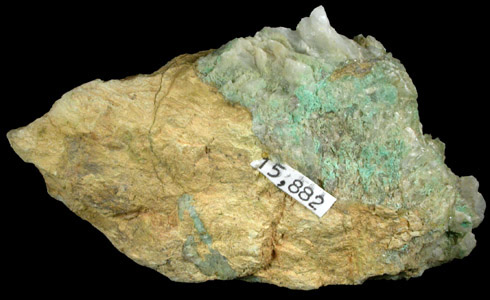Bismutite
- Wismutspat
Bismutite, not to be confused with the bismuth sulfide Bismuthinite, outdated also known as Wismutspat, is a rarely occurring mineral from the mineral class of carbonates ( and nitrates). It crystallizes in the orthorhombic crystal system with the chemical composition Bi2 [ O2 | CO3 ] and developed predominantly spherical, radial- or moderate usually white, gray or yellow color to powdery mineral aggregates. It Bismutite but were already green, blue, brown and black colored found.
Etymology and history
Was first found Bismutite in the " pit arms aid" for Ullersreuth ( Hirschberg ( Saale), Thuringia). As a first description of the mineral is considered the publication August Haupt wide by 1841, but this mentioned that already several times carbonate of bismuth oxide was found, but this was present in the mixture and could not be accurately characterized:
BREITHAUPT designated mineral in accordance with the high bismuth content of over 80%.
Classification
In the old ( 8th edition ) and new classification of minerals according to Strunz ( 9th Edition ) Bismutite belongs to the department of " anhydrous carbonates with foreign anions ." The new Strunz'sche Mineral classification divided here but still fine on the nature of the cations involved. The Bismutite can thus be found in the corresponding sub-division " with lead ( Pb) and bismuth (Bi) ".
The classification of minerals according to Dana assigns the mineral in the department of " carbonates (in addition involved ) hydroxyl groups or halogens and the general formula (A, B ) 2 ( XO) 3Zq ".
Education and Locations
Bismutite forms as a secondary mineral weathering (mostly oxidation) from other bismuth minerals or native bismuth. He will therefore be on in paragenesis with native bismuth, bismuthinite, Bismutoferrit, chalcopyrite and goethite.
Apart from its type locality Ullersreuth in Thuringia was Bismutite far (as of 2009), among others, discovered at the following localities: Assosa in Ethiopia; Córdoba in Argentina; Kadscharan in Armenia; several regions in Australia; La Paz, Oruro and Potosí in Bolivia; the south-eastern and central region of Brazil; Atacama Region in Chile; several regions of the People 's Republic of China; Baden- Württemberg ( Black Forest), Bavaria ( Fichtelgebirge, Spessart ), Hesse (Odenwald ), North Rhine -Westphalia (Sauerland, winner of the country), Saxony -Anhalt (Harz ), Saxony (Erzgebirge) and Thuringia ( Vogtland) in Germany; several regions in France; Attica in Greece; Bhilwara in India; some regions in Italy; Honshu and the Nansei Islands in Japan; in the Northwest Territories, Ontario and Quebec in Canada; Ampangabé in Madagascar; some regions in Mexico; Zambezia in Mozambique; Kivu in the Democratic Republic of Congo; Erongo and Kunene in Namibia; several regions in Norway; some regions in Austria; Lower Silesia in Poland; some regions in Russia; Bohemia in the Czech Republic; Borzsony ( Pils Mountains) in Hungary; and many regions in the United States.
Crystal structure
First structure measurements indicate Bismutite seemed to crystallize in tetragonal symmetry. However, settled with this assumption, the structure is not completely solved. A new structural analysis in 2002 finally revealed that Bismutite in the orthorhombic crystal system, space group Imm2 with the lattice parameters a = 3.865 Å, b = 3.862 Å and c = 13.675 Å and two formula units per unit cell crystallized, with the unit cell, however, a pronounced pseudotetragonale arrangement shows.

_-_Schneeberg,_Erzgebirge.jpg/240px-Bismutit_(Wismutcarbonat)_-_Schneeberg,_Erzgebirge.jpg)








